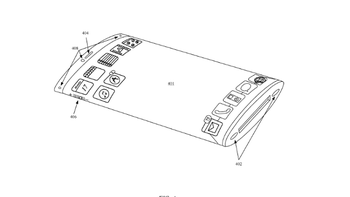Apple's new patent hints at wrap-around screen on future iPhone models

Back in 2015, Apple received a patent for a curved screen that wrapped around the front and sides of an iPhone. The regular buttons would be replaced by virtual representations along the sides, and the implementation includes a flexible screen. Obviously this approach hasn't been used yet by the company, although Apple did receive a new patent today which covers an "Electronic device with wrap-around housing."
According to the patent, content can be viewed on any portion of the wrap-around display. In addition, the device would use a pair of user interfaces. One would be employed for "the central portion of the transparent housing component, and a second user interface comprising a control input through at least one of the peripheral portions of the transparent housing component."
Similar to what was mentioned in the 2015 patent, in one version of the wrap-around screen, a second flexible display is used to create a 3D-like effect on the phone. The patent also covers the use of a wrap-around screen to create a "multi-display electronic portable device." Apple originally filed a patent application for an "Electronic device with wrap-around housing" in May, 2016. The United States Patent and Trademark Office assigned it a U.S. patent number of 9,983,630.
Will Apple use this design in a future iPhone model? We certainly wouldn't rule it out although we wouldn't expect to see something like this until 2020 at the earliest.
"An electronic device, comprising: a housing comprising a transparent housing component having a curved exterior surface formed of a single layer of transparent material, the curved exterior surface comprising a central portion surrounded on at least two sides by peripheral portions, each peripheral portion having a curvature that is greater than a curvature of the central portion; a flexible display assembly carried by the transparent housing component and arranged to display visual content through the transparent housing component, the housing being configured to prevent deformation of the flexible display assembly; and a processor configured to direct the flexible display assembly to present i) a first user interface through the central portion of the transparent housing component and ii) a second user interface comprising a control input through at least one of the peripheral portions of the transparent housing component."-U.S. Patent 9983630
Check out images from the patent at the top of this story, and in the slideshow below.
source: USPTO










Things that are NOT allowed: